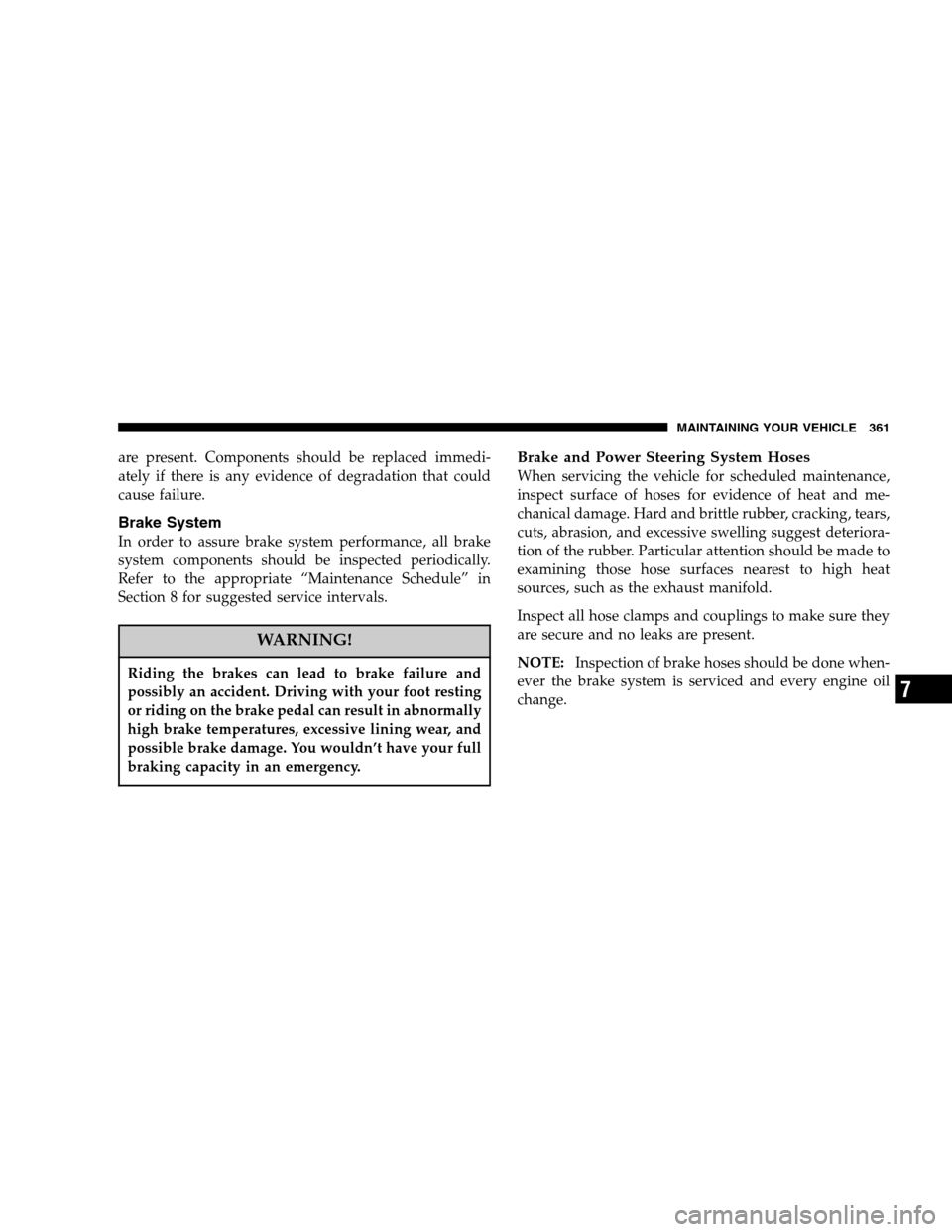oil temperature DODGE NITRO 2007 1.G Owners Manual
[x] Cancel search | Manufacturer: DODGE, Model Year: 2007, Model line: NITRO, Model: DODGE NITRO 2007 1.GPages: 436, PDF Size: 1.68 MB
Page 344 of 436

Checking the oil while the vehicle is on level ground will
improve the accuracy of the oil level readings. Always
maintain the oil level within the SAFE zone on the
dipstick. Adding one quart of oil when the reading is at
the bottom of the SAFE zone will result in a reading at the
top of the safe zone on these engines.CAUTION!
Overfilling or underfilling the crankcase will cause
aeration or loss of oil pressure. This could damage
your engine.
Change Engine Oil
Road conditions as well as your kind of driving affect the
interval at which your oil should be changed. Check the
following to determine if any apply to you:
•Day or night temperatures are below 32°F (0°C)
•Stop and go driving
•Extensive engine idling
•Driving in dusty conditions
•Short trip driving of less than 10 miles (16.2 km)
344 MAINTAINING YOUR VEHICLE
Page 346 of 436

Engine Oil Viscosity (3.7L Engine)
SAE 5W-20 engine oil is recommended for all operating
temperatures. This engine oil improves low tempera-
ture starting and vehicle fuel economy. Your engine oil
filler cap shows the recommended engine oil viscosity
for your vehicle.
Lubricants which do not have both, the engine oil certi-
fication mark and the correct SAE viscosity grade num-
ber should not be used.
Engine Oil Viscosity (4.0L Engine)
SAE 10W-30 engine oil is recommended for all operat-
ing temperatures. This engine oil improves low tem-
perature starting and vehicle fuel economy. Your engine
oil filler cap shows the recommended engine oil vis-
cosity for your vehicle.
Lubricants which do not have both, the engine oil certi-
fication mark and the correct SAE viscosity grade num-
ber should not be used.
Materials Added To Engine Oils
The manufacturerstrongly recommendsagainst the ad-
dition of any additives (other than leak detection dyes) to
engine oil. Engine oil is an engineered product and it’s
performance may be impaired by supplemental addi-
tives.
Disposing of Used Engine Oil
Care should be taken in disposing of used engine oil from
your vehicle. Used oil, indiscriminately discarded, can
present a problem to the environment. Contact your
authorized dealer, service station, or governmental
agency for advice on how and where used oil can be
safely discarded in your area.
Engine Oil Filter
The engine oil filter should be replaced at every engine
oil change.
NOTE:For best access to the oil filter, a drive on hoist
should be used instead of a chassis hoist (3.7L Only).
346 MAINTAINING YOUR VEHICLE
Page 361 of 436

are present. Components should be replaced immedi-
ately if there is any evidence of degradation that could
cause failure.
Brake System
In order to assure brake system performance, all brake
system components should be inspected periodically.
Refer to the appropriate “Maintenance Schedule” in
Section 8 for suggested service intervals.
WARNING!
Riding the brakes can lead to brake failure and
possibly an accident. Driving with your foot resting
or riding on the brake pedal can result in abnormally
high brake temperatures, excessive lining wear, and
possible brake damage. You wouldn’t have your full
braking capacity in an emergency.
Brake and Power Steering System Hoses
When servicing the vehicle for scheduled maintenance,
inspect surface of hoses for evidence of heat and me-
chanical damage. Hard and brittle rubber, cracking, tears,
cuts, abrasion, and excessive swelling suggest deteriora-
tion of the rubber. Particular attention should be made to
examining those hose surfaces nearest to high heat
sources, such as the exhaust manifold.
Inspect all hose clamps and couplings to make sure they
are secure and no leaks are present.
NOTE:Inspection of brake hoses should be done when-
ever the brake system is serviced and every engine oil
change.
MAINTAINING YOUR VEHICLE 361
7
Page 389 of 436

Schedule “B”
Follow this schedule if you usually operate your vehicle
under one or more of the following conditions.
•Day or night temperatures are below 32°F (0°C)
•Stop and go driving
•Excessive engine idling
•Driving in dusty conditions
•Short trips of less than 10 miles (16.2 km)
•More than 50% of your driving is at sustained high
speeds during hot weather, above 90°F (32°C)
•Trailer towing
•Taxi, police, or delivery service (commercial service)
•Off-road or desert driving
•If equipped for and operated with E-85 (ethanol)
fuel.
NOTE:IfANYof these apply to you then change your
engine oil every 3,000 miles (5 000 km) or 3 months,
whichever comes first and follow “Schedule B” of the
“Maintenance Schedules” section of this manual.
NOTE:IfANYof these apply to you then flush and
replace your engine coolant/anti-freeze every 102,000
miles (170 000 km) or 60 months, whichever comes first,
and follow “Schedule B” of the “Maintenance Schedules”
section of this manual.
SCHEDULE “B” 389
8
M
A
I
N
T
E
N
A
N
C
E
S
C
H
E
D
U
L
E
S
Page 423 of 436

Selection of Coolant (Antifreeze)......356,382,383
Temperature Gauge..................... 164
Corrosion Protection..................... 366
Crankcase Emission Control System.......... 350
CupHolder ............................ 147
Customer Assistance..................... 412
Data Recorder, Event...................... 61
Daytime Running Lights................... 122
Dealer Service.......................... 343
Defroster, Rear Window................... 156
Defroster, Windshield................ 76,230,231
Delay (Intermittent) Wipers................. 122
Diagnostic System, Onboard................ 340
Dimmer Switch, Headlight..............120,166
Dipsticks
Oil (Engine).......................... 343
Disposal
Engine Oil........................... 346Used Coolant (Antifreeze)................ 358
Door Locks............................. 27
Door Locks, Automatic.................... 30
Door Opener, Garage..................... 134
DriveBelts ............................ 347
Driving ............................... 262
DVD Player (Video Entertainment System)...... 225
Electric Remote Mirrors.................... 83
Electrical Outlet, Auxiliary (Power Outlet)...... 144
Electrical Power Outlets................... 144
Electronic Brake Control System............. 128
Electronic Speed Control (Cruise Control)...... 125
Electronic Stability Program (ESP).........131,166
Electronic Vehicle Information Center (EVIC).... 179
Emergency, In Case of
Hazard Warning Flasher................. 324
Jacking............................. 326
Towing ............................. 334
INDEX 423
10
Page 424 of 436

Emission Control System Maintenance......341,386
Engine
Air Cleaner.......................... 350
Block Heater......................... 243
Break-In Recommendations................ 74
Compartment......................338,339
Compartment Identification............338,339
Coolant (Antifreeze).................... 383
Exhaust Gas Caution.................. 74,299
Fails to Start.......................... 240
Flooded, Starting...................... 240
Fuel Requirements..................296,382
Jump Starting......................... 332
Oil ...........................343,382,383
Oil Disposal.......................... 346
OilFilter ............................ 346
Oil Selection.......................... 382
Overheating.......................... 325
Starting............................. 239Temperature Gauge..................... 164
Engine Oil Viscosity...................... 346
Engine Oil Viscosity Chart................. 346
Enhanced Accident Response Feature.......... 60
Entry System, Illuminated.................. 20
Event Data Recorder...................... 61
Exhaust Gas Caution................... 74,299
Exhaust System......................... 355
ExteriorFinishCare ...................... 367
Fabric Care............................ 369
Filters
Air Cleaner.......................... 350
Engine Fuel.......................... 350
Engine Oil........................346,383
FinishCare ............................ 367
Flashers
Hazard Warning....................... 324
Turn Signal.....................167,379,381
424 INDEX